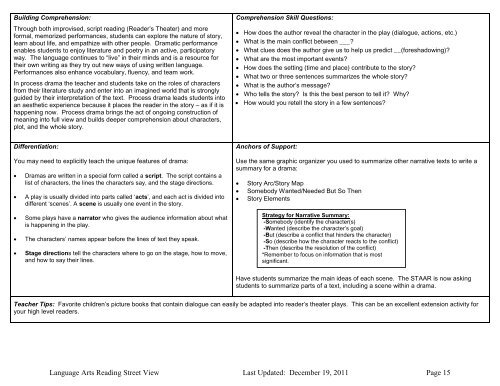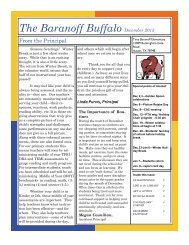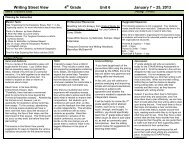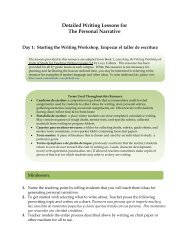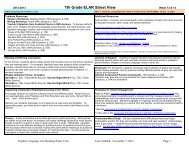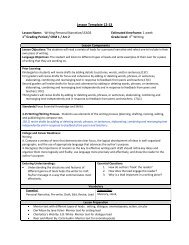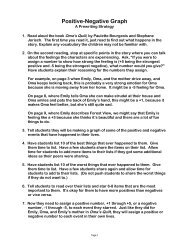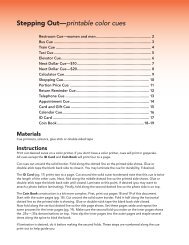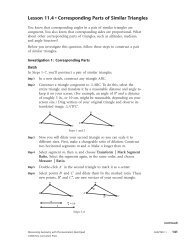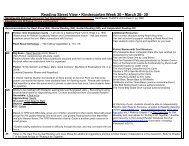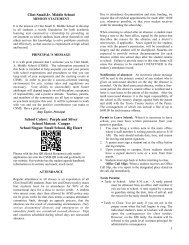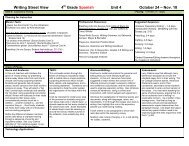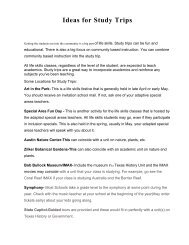<strong>Reading</strong> Street View • <strong>5th</strong> Grade • Week 26 • Feb. 21-24Arc: Summary of Fiction: DramaUnit 8: Re<strong>view</strong> of SummarizationRecommendations for Read Aloud (RA), Shared <strong>Reading</strong> (SR), Guided <strong>Reading</strong> (GR), and Independent <strong>Reading</strong> (IR)RA /SR:GR:Anansi and Common Sense, Treasures, Unit 3, pgs. 252-253The Catch of the Day: A Trickster Play, Treasures, Unit 3, pgs. 255-270This would be a good <strong>week</strong> to use reader’s theater scripts during small group instruction.Students can work both on the comprehension skills of the <strong>week</strong> as well as practicefluent reading.Additional Resources for Read Aloud:Online Plays for ChildrenReader’s Theater ScriptsThe Treasures Read Aloud Anthology has several plays you mayuse.IR:By now your students should be independently seeking out books appropriate to their independent reading levels and interests. For students who seem resistant to adoptingreading as a personal past time, don’t give up on this crucial piece of instruction. Continue to offer reluctant readers books that vary by genre, subject, theme, style, and form.Insist that they read at least one chapter to see if it’s a fit. Consider the student’s other activities and personal interests to help guide you. Ask the student what types of texthe/she would enjoy reading most. Try pairing the student with an enthusiastic, friendly reader for partner reading (same books). Keep trying to find that “in” that will get evenyour reluctant readers hooked on reading.Discussing Genre:<strong>Reading</strong> drama is very different from otherfiction and nonfiction genres, though it canfall into both categories. Thecomprehension foci this <strong>week</strong> is onsummarizing plot, roles and functions ofcharacters (as well as relationships andconflict). An additional focus is point of<strong>view</strong>. These can all be taught throughdrama. .Building fluency is one of the five majordictates set up in <strong>Reading</strong> First, part of theNo Child Left Behind Act. Put <strong>Reading</strong>First, a booklet published by the U.S.Department of Education et al (2001),states that "Readers' theatre providesreaders with a legitimate reason to rereadtext and to practice fluency. Readers’theatre also promotes cooperativeinteraction with peers and makes thereading task appealing."If you want to get your kids reading withcomprehension, expression, fluency, andjoy, Reader’s Theater is an excellentinstructional strategy.Word Study:Suffixes• Use the routines and activities forPHONICS FOCUS described inTreasures TE (p. 525C).• After explicit instruction, use the 5-DaySpelling activities (Treasures TE,549E) to practice PHONICS FOCUS.• Homework: PHONICS FOCUSactivities; Phonics / Spelling PracticeBook, p. 121-126. (On CD)• Application: Have students practicereading the PHONICS FOCUSpassages on p. 25 of the Teacher'sResource Book (On CD) until they areable to read them fluently.• Use Speed Drill on p. 140 of Teacher'sResource Book (On CD)Fluency:Use Transparency 11 for repeatedchoral reading and paired studentpractice of an excerpt from Catch of theDay: A Trickster Play. (See TreasuresTE, p. 273A)☼TIP: Poetry Slam: For several <strong>week</strong>s,poetry has been mentioned as a way tohelp students with their fluency. Compileall of the poems that you have beenpracticing into folders for each of yourstudents, and have students select a fewpoems for a Poetry Slam. Have studentspractice their poem recital with fluencyand attitude -- a Poetry Slam is all aboutattitude and presentation. (Lots of greatvideos of Poetry Slams are available onthe internet: search for "High SchoolPoetry Slam" for videos to show yourstudents.)Vocabulary:wares, treasurer, merchandise, instruct,burden, educate, appreciation,unfortunateSee the 5-Day Robust Vocabularyroutines in Treasures, Unit 3, pgs.277C-277D.Language Arts <strong>Reading</strong> Street View Last Updated: December <strong>19</strong>, 2011 Page 14
Building Comprehension:Through both improvised, script reading (Reader’s Theater) and moreformal, memorized performances, students can explore the nature of story,learn about life, and empathize with other people. Dramatic performanceenables students to enjoy literature and poetry in an active, participatoryway. The language continues to “live” in their minds and is a resource fortheir own writing as they try out new ways of using written language.Performances also enhance vocabulary, fluency, and team work.In process drama the teacher and students take on the roles of charactersfrom their literature study and enter into an imagined world that is stronglyguided by their interpretation of the text. Process drama leads students intoan aesthetic experience because it places the reader in the story – as if it ishappening now. Process drama brings the act of ongoing construction ofmeaning into full <strong>view</strong> and builds deeper comprehension about characters,plot, and the whole story.Comprehension Skill Questions:• How does the author reveal the character in the play (dialogue, actions, etc.)• What is the main conflict between ___?• What clues does the author give us to help us predict __(foreshadowing)?• What are the most important events?• How does the setting (time and place) contribute to the story?• What two or three sentences summarizes the whole story?• What is the author’s message?• Who tells the story? Is this the best person to tell it? Why?• How would you retell the story in a few sentences?Differentiation:You may need to explicitly teach the unique features of drama:• Dramas are written in a special form called a script. The script contains alist of characters, the lines the characters say, and the stage directions.• A play is usually divided into parts called ‘acts’, and each act is divided intodifferent ‘scenes’. A scene is usually one event in the story.• Some plays have a narrator who gives the audience information about whatis happening in the play.• The characters’ names appear before the lines of text they speak.• Stage directions tell the characters where to go on the stage, how to move,and how to say their lines.Anchors of Support:Use the same graphic organizer you used to summarize other narrative texts to write asummary for a drama:• Story Arc/Story Map• Somebody Wanted/Needed But So Then• Story ElementsStrategy for Narrative Summary:-Somebody (identify the character(s)-Wanted (describe the character’s goal)-But (describe a conflict that hinders the character)-So (describe how the character reacts to the conflict)-Then (describe the resolution of the conflict)*Remember to focus on information that is mostsignificant.Have students summarize the main ideas of each scene. The STAAR is now askingstudents to summarize parts of a text, including a scene within a drama.Teacher Tips: Favorite children’s picture books that contain dialogue can easily be adapted into reader’s theater plays. This can be an excellent extension activity foryour high level readers.Language Arts <strong>Reading</strong> Street View Last Updated: December <strong>19</strong>, 2011 Page 15


